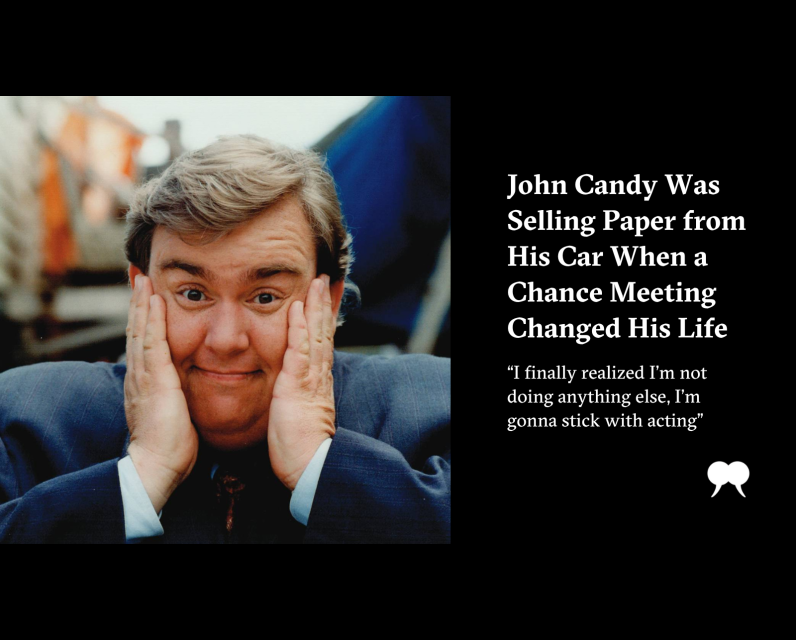John Candy Was Selling Paper from His Car When a Chance Meeting Changed His Life

John Candy met talent agent Catherine McCartney by accident. Striking up an awkward conversation after nearly knocking her over in line at the Eaton’s cafeteria, he discovered that her talent office just happened to be across the street, next to Fran’s Restaurant where he sometimes dined. McCartney later saw him at Fran’s and invited him up to her office, where he shyly confessed to her that he had been taking acting classes with an eye toward becoming a professional actor. Charmed by Candy’s baby face and disarming wit, McCartney was eager to help him get a foot in the door. In 1970, she happened to be casting for a television commercial in which a high school football player would expound on the virtues of Colgate toothpaste. She knew just who to send out on the audition.
Candy had played this character in real life, and after passing the audition, he found himself walking across a studio floor in full football padding to a locker room set where he joined Canadian-born icon of American television Art Linkletter, whom Candy recognized from his 1950s television program People Are Funny. “My one big line was ‘Oh sure, Casanova!’” Candy later told David Letterman on his Late Night talk show. “[We did] about a hundred takes of that.”
Candy immediately felt at home on set and discovered an instant and easy rapport with the film crew, breaking up a long day with well-placed laughs between takes. The Colgate spot gave him confidence to ask McCartney to send him out for more commercials, and he booked a few. One was for Molson Golden Ale, and Candy was thrilled to see it running constantly during the CBC’s Hockey Night in Canada broadcasts, where all of his old Neil McNeil High School pals were sure to see it.
Meeting frequently in McCartney’s talent office, McCartney and Candy chatted about life, the universe, and everything, bonding over the sad coincidence of them both having lost their fathers at a young age.
“John had a quality of vulnerability,” McCartney later told journalist Martin Knelman. “He was young and awfully cute. John had the ability to make people feel special even if he had only known them a short time. Once he became your friend, he was always there for you, to listen and provide a shoulder to cry on.”
As Candy dared to dream aloud of fame and fortune, McCartney was ready to guide him where he needed to go. He continued to pursue work on the stage, taking on a supporting role in a Bill Glassco production of David Freeman’s savagely sardonic play Creeps at Toronto’s Tarragon Theatre, and other small parts. Candy was earning only $40 a week, but he was now a professional working stage actor, happy to be paid at all. He split his time between acting and a series of aimless day jobs. These included selling paper products door to door for Perkins Paper out of the back of his beat-up brown Pontiac and also working part time at Eaton’s.
It was there in 1972 that fate once again crossed the threshold to meet him, in the form of a young actor named Valri Bromfield. “I went into Eaton’s to buy something and there was John,” says Bromfield. “He was so sweet and nice and funny. If somebody makes me laugh, I’ll just stand there and laugh, it’s like an addiction. And it’s deadly because you don’t care about anything else. Building on fire? ‘Oh, that was funny.’ John was like that. Everything he did, he just kept tripping over great, great lines, the next one came, and he was funny and we fed each other. He just seemed glowing and brilliant to me.”
Bromfield and her comedy partner, Dan Aykroyd, had recently moved to Toronto from Ottawa, where they had created a local television sketch comedy program called Change for a Quarter. They had shown tapes of the program to Toronto-born writer and performer Lorne Michaels, who had just left a CBC television sketch program of his own, The Hart and Lorne Terrific Hour, with Hart Pomerantz. While that series had aired for only one season in 1970, Michaels was clearly going places, and his encouragement was all that Aykroyd and Bromfield needed to make the move to Toronto. There, they became regular performers at late-night venues around the city, such as the Platform, where a young entrepreneur named Andrew Alexander was the talent booker, or at the Global Village theatre, where an unknown Gilda Radner worked the box office.
Bromfield had also been performing for children with the Caravan Theatre troupe, staging plays in hospitals, schools, public parks, and a few indoor venues such as Toronto’s Poor Alex Theatre, funded by a modest arts grant from the federal government. She suggested that Candy meet with Caravan’s director, Stephen Katz. “Stephen had said he needed a big guy to play a king and a bunch of other parts,” says Bromfield, “so I just told John, ‘You know what? You should quit your day job,’ which paid real money, ‘and come make nothing with us. We all squeeze into one car and go do children’s theatre. It’ll be fun!’”
To Bromfield’s surprise, Candy agreed to jump into his battered Pontiac and meet with Katz, who hired him on the spot. Candy cut an imposing figure and showed impressive range, handling roles great and small with equal finesse.
“John was just fabulous as this very stately king, and children just loved him,” says Bromfield. “He’d try to break us up onstage or make us forget our lines, and we’d sneak in all this double-entendre stuff. We had a lot of fun, and the fun never left us.”
Bromfield had been telling Aykroyd about Candy for weeks by the time she finally made the introductions one afternoon at her place on Yonge Street.
“I had been walking with my friend Marcus O’Hara,” says Aykroyd, “and Valri yelled at me from a building she was living in. I went up to her apartment, where I met John Candy for the first time. He had that big brown Pontiac, and he was always beautifully turned out, a real clothes horse. He loved smart blazers and nice slacks, shoes, and shirts.”
By now, Aykroyd trusted Bromfield’s judgment about the people she brought into their ever-widening social circle within the relatively insular Toronto scene, and a shockingly high ratio of their talented new acquaintances seemed destined for bigger things. Many of them, including Radner, who had just arrived from Detroit, had been introduced to the circle through Marcus O’Hara, a social connector and the brother of Catherine and Mary Margaret O’Hara.
“We were all hanging out,” says Aykroyd, “but Candy and I were in other careers when we met. I knew he had done theatre in high school, but he was right there in the working world; I was a mailman, he was a paper salesman.”
By Candy’s own admission, he had been a terrible salesman, routinely ranked last among his forty fellow hustlers. “I had a trunk that was filled with Halloween, Valentine’s Day, Easter, Happy Birthday greetings from the Disney characters,” Candy later explained to City Lights host Brian Linehan. “While I was rehearsing . . . I was supposed to be on the road, and they finally caught up to me and fired me.”
He took his boss’s parting shot, that he “never should have hired an actor,” as an unintended confirmation of his true calling and vowed he would never work as a salesman again.
“I finally realized I’m not doing anything else,” Candy told Linehan. “I’m gonna stick with acting.”
While a natural comic actor, Candy made no secret of his desire to also tackle a dramatic role like Willy Loman in Arthur Miller’s Death of a Salesman, but for now, he was content to do whatever theatre work he was offered, which included joining James Iwasuk’s children’s theatre troupe, the Jolly Jesters, to bring Rumpelstiltskin and Treasure Island to Toronto-area schools.
Still living at his childhood home in East York, Candy took on additional responsibilities for the Jesters, at turns stage managing, loading all the props and backdrops into a rented cube van, and driving the cast all over Metropolitan Toronto for the measly wage of $65 per week.
In the fall of 1972, Katz tapped Candy to return to the Tarragon Theatre in Sheldon Rosen’s adaptation of Carlo Gozzi’s eighteenth-century Italian comedy The Stag King, about a king who awakens in an enchanted forest in the body of a stag. Candy was working constantly, but he wasn’t getting rich, owing as much to the limited wages as to his burgeoning taste for the finer things.
“I’ve always lived beyond my means,” Candy later confessed to the CBC’s Peter Gzowski. “I always had an apartment that was great. I never did without. I probably had more fun then, but I don’t look at the zeroes, I mean they’re there . . . my accountant is still always screaming at me ‘John, for god’s sakes!’ You know, I probably lend too much money to people.”
Increasingly, Candy found himself socializing with the network of fellow aspiring actors he was meeting through Aykroyd, Bromfield, and O’Hara. In the 1970s, the Toronto bars still closed at midnight, and so, to accommodate their fellow bohemian night owls, Aykroyd and O’Hara launched a speakeasy at 505 Queen Street East. The 505, as it was known, was a late-night refuge, not just for actors and musicians but streetcar drivers, restaurant and bar workers, and nurses and doctors who convened to loosen up after their night shifts, far from the prying eyes of the parochial liquor board laws of Toronto the Good.
Legendarily, the 505 was also where Aykroyd would later meet John Belushi and dream up the Blues Brothers act after grooving to the Downchild Blues Band until the sun came up.
“The 505 was initially a storefront place that I rented,” says Bromfield. “It was two doors down from a cafe where a guy made pies at four in the morning, and Marcus came and lived with me in that house. Then Danny took it over and turned it into an off-licence.”
“It was a great environment,” says Aykroyd. “There should be a plaque on that building because all of the comedy stars and music stars [who] came through there. Also, there should be a plaque at 1063 Avenue Road.”
1063 Avenue Road was a rented house in the Eglinton-Lawrence neighbourhood of Toronto that would later come to play an important role in exportable Canadian culture. The Victorian detached brick house had initially been rented by aspiring actor friends Eugene Levy, Martin Short, and Dave Thomas, all of whom had met as students at McMaster University in Hamilton, Ontario, and were now part of the young Toronto cast of the post-hippie stage musical Godspell, which had become something of a phenomenon in local theatre circles.
Godspell, composed by Stephen Schwartz with a book by John-Michael Tebelak, had opened off-Broadway at the Cherry Lane Theatre in May 1971 and had produced a Billboard Top 20 single in “Day by Day” in the summer of 1972. That same year, a Toronto production opened to rave reviews and launched the careers of many of its cast members, including Victor Garber, Paul Shaffer, Howard Shore, Gerry Salsberg, Eugene Levy, Andrea Martin, Gilda Radner, Martin Short, and Dave Thomas.
Levy, Martin, Radner, Short, and Thomas were frequently among the revellers at the house on Avenue Road, along with Aykroyd and Bromfield, who soon introduced Candy to the clique. By this time, Candy was at last in a serious relationship. In 1969, he had met Rosemary Hobor, a young student at the Ontario College of Art, and by the time they walked through the door together at 1063 Avenue Road for what came to be known as the weekly Friday Night Services, their relationship status had been upgraded from steady to serious.
According to Thomas, the sheer brilliance of the talent at Friday Night Services sometimes fostered a competitive atmosphere.
“It was a social scene,” says Thomas, “with all these people connecting on their similar sense of comedy and making each other laugh. But sometimes it was also kind of scary because there was always a question of ‘Am I actually good enough to be in the company of these people?’ Because they’re really good.”
A typical night included performing songs and improvised skits. And everyone was obliged to take a turn at a popular game that involved riffing along with an Albert Brooks comedy album called Comedy Minus One.
“Albert had written scripts in the liner notes,” says Thomas, “and you would put on the album and read along with the scripts. Albert would say a line [on the record] and then it was your cue to do the next line. At the start of the bit, Albert gave you plenty of time to say your dialogue, then the pace picked up and you had no time at all. It was a fun game for us, and it created an opportunity for us to perform for each other.”
While Catherine O’Hara didn’t consider herself “deep in the circle,” she also felt welcomed by the Godspell crowd at 1063.
“It was really fun,” says O’Hara. “Andrea and Marty had done a lot of stage in Toronto, musicals. It was a really ridiculously talented crowd, and it was really exciting to be around them and to watch them with each other, and they’re all lovely people. The Comedy Minus One game became a kind of all-in-good-fun initiation ritual for first timers. Somebody would put on the album and go, ‘Hey you. First time here? Why don’t you come on and try this album?’”
Soon, Candy was taking a turn with the Brooks album, and in no time, he became a beloved regular at the Friday Night Services. In a 1989 feature for The New Yorker, writer James Kaplan summed up the talent pool surrounding the Toronto cast of Godspell as “one of those artistic nexuses that crop up now and then, like Paris in the twenties, Los Angeles in the thirties, London just before the First World War.”
As Shaffer tickled the keys of the house piano, Short worked out his generic lounge singer character, which later became his standing schtick on David Letterman’s Late Night when Shaffer was the bandleader.
“We’d have parties, and everyone would just get up,” says Short. “Paul would play, I’d sing, Gilda would sing. And we’d all just do songs from Godspell.”
Short, who met Candy for the first time backstage after a Godspell performance, recalls that Candy made it known that he had a low tolerance for the constant singing of Godspell songs at 1063.
“John thought it was insane. We were singing it all day, then singing it at night. I think it seemed obsessive to him,” says Short.
“No one particularly thought they’d ever become successful outside of Toronto. It wasn’t like people were saying, ‘Someday we’re going to be in the movies,’ or something.”
By her own description, 1063 regular Jayne Eastwood was “already semi-famous in Toronto” as one of the stars of Donald Shebib’s influential 1970 Canadian independent film Goin’ Down the Road when she began showing up at what she calls “the best parties ever.”
“I remember that’s where Eugene [Levy] and [his wife] Deb [Divine] first hooked up,” says Eastwood, “and John and Rose were there all the time. I’ve never laughed so hard in my life. I don’t think any of us knew how famous we were going to become.”
Meanwhile, down on Queen Street, Aykroyd and Bromfield were excited about auditioning for an improvisational theatre company founded in Chicago that was about to open a Toronto branch. It was called the Second City, and it was about to change everything.
Excerpted from John Candy: A Life in Comedy by Paul Myers, 2025, published by House of Anansi. Reprinted with permission from the publisher.
The post John Candy Was Selling Paper from His Car When a Chance Meeting Changed His Life first appeared on The Walrus.


Comments
Be the first to comment